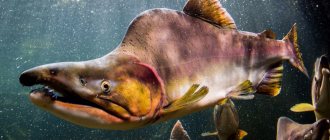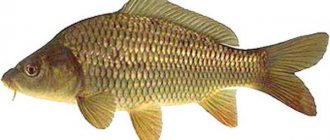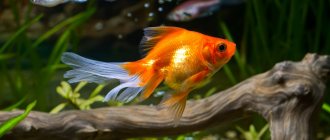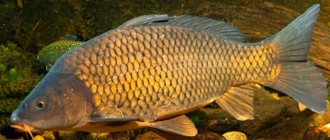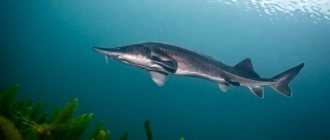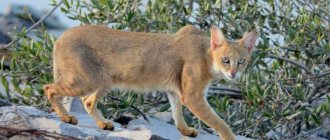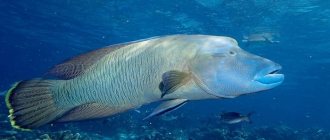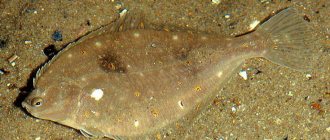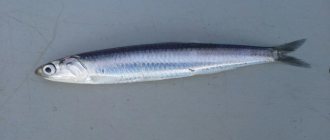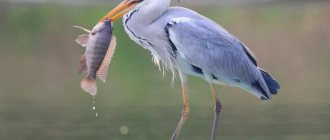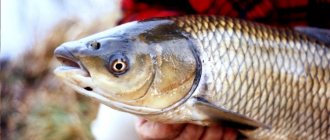Sterlet (Acipenser ruthenus) belongs to the sturgeon family, the oldest subclass of cartilaginous fish, which have remained virtually unchanged since their origin in the Silurian period. Sterlet is the smallest of all sturgeons. It has excellent taste, for which in ancient Rus' it was considered a “royal” fish and was prohibited from being caught by ordinary people.
Now sterlet is listed in the International Red Book, its fishing is prohibited. For commercial purposes, sterlet is bred on fish farms; for this purpose, Russian breeders obtained a hybrid of beluga and sterlet - bester, which combines the fertility of sterlet and the rapid growth of beluga.
Appearance and structure
Structure
Sterlet, like other sturgeons, is a cartilaginous-boned fish whose scales grow together and form bony growths covering the head and entire body. The narrow, streamlined body ends in a strong tail with a long upper ray.
Sterlet, like other sturgeon fish, does not have a bony spine. Instead, there is a notochord - cartilage, which forms the basis of the fish skeleton. In both young and adult fish, the skeleton and skull are made of cartilage. The swim bladder is large, located in the lower part of the spine, and has a connection to the esophagus. The sterlet has four main and two accessory gills; there are no gill rays. There is a hole (spray) leading from the gill cavity to the upper edge of its cover.
Body
The sterlet has a long, elongated, triangular body, resembling a spindle in shape. The sterlet does not have scales in the usual sense of the word. The body has five longitudinal lines of bone scutes - bugs:
- dorsal,
- two side ones,
- two abdominal.
Sturgeon bugs (emphasis on U) are diamond-shaped bony plates of fused modified ganoid scales containing an enamel-like substance. They look like ridge-like projections in the form of grains. The bugs perform a protective function. There are usually 12-11 dorsal bugs, 10-20 ventral bugs. At the base of the pelvic fin is the anus.
Head
The head is quite small in proportion to the body. The sterlet's snout is elongated, slightly flattened from top to bottom, and resembles a cone in shape. The lower lip is divided into two parts, which serves as one of the distinguishing features of the sterlet from other sturgeon fish.
On the lower part of the snout there are four small antennae resembling a fringe. They serve as a tactile organ, allowing them to move and feed in conditions of poor visibility. In muddy water, a sterlet can feel the bottom with its antennae and look for food. Other sturgeon species also have these antennae. The top of the head is covered with fused bone scutes, which serve as reliable protection. The eyes are small and protruding.
Mouth
The mouth is small, located on the underside of the snout after the antennae. The sterlet's mouth is fleshy and does not have hard protective plates. When grabbing food, it can move forward. The sterlet has no teeth.
Fins
The fins of the sterlet are hard. The dorsal fin is located towards the very tail of the fish and has from 30 to 50 rays. The pectoral fin contains a spine, which can be used to determine the age of the caught fish. The anal fin is well defined, it usually has 15-35 rays. The caudal fin is divided into two lobes, the upper one being much longer and larger than the lower one. This tail shape is characteristic of all sturgeons.
Body coloring
The sterlet has a dark gray-brown color on the back and sides. The color of the sterlet’s body depends on the specific habitat and varies from brown to dark sand and gray; in the light it can turn dark green. The belly is light gray, sometimes almost white.
Sexual dimorphism
Sterlet has no sexual dimorphism. This means that female and male individuals do not differ at all from each other in appearance: neither in size, nor in shape, nor in color. This phenomenon is quite rare in the animal world.
Dimensions
Of all sturgeon fish, sterlet is the smallest in size. On average, adult individuals grow to 50-60 centimeters and weigh 1-2 kilograms. A sterlet weighing 3-4 kilograms is considered a trophy. Cases of catching specimens weighing 20 kilograms and 120 centimeters long are described. Under favorable living conditions and the presence of a sufficient food supply, sterlet can grow up to 110-120 centimeters and weigh 14-16 kilograms.
Description and features
The underwater world is very rich in inhabitants. There are several tens of thousands of fish species alone there. But there are some of them who received the honorary title of “royal”. These include the sturgeon fish sterlet . But why and for what did she deserve such a title? This is what we have to figure out.
If you believe the tales of fishermen of the past, then such underwater creatures were not small. Some of them, becoming the pride of the lucky ones who caught them, reached almost two meters in length, and their carcass weighed about 16 kg. It may very well be that all this is fiction, or perhaps times have simply changed.
But the average sterlet of our day is much more compact, especially the males, which, as a rule, are smaller and thinner than the more impressive female representatives. The usual size of such fish is now about half a meter, and the weight does not exceed 2 kg. Moreover, adult specimens weighing 300 g and a size not exceeding 20 cm should be considered quite common.
The appearance features of these underwater inhabitants are unusual and differ from the shape and structure of most fish in many interesting details. The sloping, elongated, cone-shaped front part of the sterlet ends in a slightly curved upward, pointed, elongated nose. Tapering towards the end, its length is almost comparable to the head of the fish itself.
But in some cases it is not very prominent, rounded. Beneath it one can see a mustache falling like a fringe. And the expressiveness of the muzzle is added by small eyes located on both sides.
The mouth is like a slit cut from the bottom of the snout; its lower lip is forked, which is an important characteristic feature of these creatures. Their tail has the shape of a triangle cut in two, with the upper part of its fin protruding more than the lower.
Another interesting feature of such a fish is the absence of scales on its long body with rather large, curly gray fins, that is, in the usual sense for us. It is replaced by bone shields. The largest of them are arranged in longitudinal rows.
The largest ones, equipped with spines and having the appearance of a continuous wave-like crest, replace the dorsal fins of these wonderful creatures. A number of shields are also visible on both sides. And two more border the belly, the main area of which is unprotected and vulnerable.
In those parts of the fish’s body where rows of large scutes are absent, only small bony plates cover the skin, and sometimes it is completely bare. In short, these creatures look really unusual. But no matter how much you describe it, it is impossible to imagine their appearance unless you look at a photo of a sterlet .
For the most part, the color of the back of such fish is brown with a grayish or darker tint, and the belly is light with a yellowish tint. But depending on the individual characteristics and habitat, the colors vary. There are specimens the color of rain-soaked asphalt or gray-yellow, sometimes a little lighter.
What fish can be confused with
Sturgeon
Sterlet is quite easy to confuse with other sturgeons. There are several specific characteristics that will help distinguish sterlet from other species of the family.
- Fish sizes. Sterlet is the smallest representative of the sturgeon family. The average length of an adult is 50-60 cm, the average weight is 1-2 kg. Other sturgeon representatives are much larger, can reach several meters in length and weigh more than a hundred kilograms.
- The structure of the head . The wild, uncultivated sterlet has a sharp snout shaped like a narrow cone. The head is small, flattened, narrow. The sturgeon has a larger head in relation to its body, and a blunt, short, wide nose.
- Appearance . It is difficult to distinguish different types of sturgeon by body color; they may have similar colors. What matters is the number of bugs - bony plates covering the body of the fish. The sturgeon has a smoother body, the number of bugs is no more than 50, and the shape of the bugs is rounded. The sterlet has a much larger number of bugs (about 70) and they have a sharper shape, reminiscent of thorns. The bugs are very tightly packed on the back (12-17 pieces). There are clearly visible gaps between the abdominal bugs (13-15). In the lateral line there are 60-70 small diamond-shaped bugs.
What is the difference between sterlet and sturgeon
The general external characteristics of most sturgeons are quite similar, however, there are several signs that allow you to accurately determine the type of fish. The main difference between sterlet and sturgeon is the size and weight of adults. Sturgeon can grow up to 1.5 m or more with a weight of 15-20 kg, while the average length of a sterlet is between 40-60 cm and a weight of 1-3 kg.
You can distinguish juvenile sturgeon from adult sterlet by the following features:
| What to pay attention to | Sterlet | Sturgeon |
| Head | The nose is elongated and pointed, the antennae located near the mouth have a fringe. | The nose is moderately elongated, rounded, the antennae are devoid of fringe. |
| Bone growths | The scutes have spines, their number in the lateral rows reaches 70, with the growths touching each other. | The scutes are without spines; there are from 36 to 56 growths on the sides. |
| Body Shape | The body is elongated, thinner. | The body resembles a spindle, the middle part is thicker. |
When comparing the taste of two types of fish, sterlet will be more tender and juicy, since the amount of fat in it is almost twice as much as in sturgeon.
SALMON
Distribution area
Initially, the sterlet inhabited the reservoirs of the Eastern European part of Russia and Western Siberia.
Currently, the range of sterlet has decreased significantly, which has been facilitated by pollution of water bodies and uncontrolled fishing of this valuable fish. Previously, sterlet inhabited rivers belonging to the basins of the seas: the Baltic, Azov, Black, Caspian, White and Barents. Found in large Russian rivers: Volga, Yenisei, Amur, Ob; in the northern lakes: Onega and Ladoga. Sterlet inhabits the Don, Ural, Sura, Kama, Kuban, Klyazma, Angara and Irtysh in small populations. Sterlet was artificially introduced into the Oka River, Northern and Western Dvina, Neman, Pechora, Amur and some reservoirs.
You may be interested in: Sunline FC Sniper Fluorocarbon Line
Sterlet lifestyle
Sterlet is a purely river fish, found only in exceptional and extremely rare cases in brackish parts of the seas, usually near river mouths. Constantly lives in river beds. In the lower reaches of the Volga and in its delta, sterlet is a semi-anadromous fish. This semi-anadromous sterlet spawns above the delta, and its fry migrate to the northern, desalinated part of the sea. All summer, sterlet is found more in shallow water, where the organisms on which it feeds are concentrated. Juveniles are found in channels, waterways, estuarine bays, and individual flowing shallow waters.
It does not make long migrations in the river. In the fall, in September, it gathers in deep areas (pits), where it spends the entire winter in a sedentary state, without feeding. The time for laying in pits on the Volga is determined by mid-September. In the spring, when the ice breaks up, the sterlet rises from the pits and moves up the river, with the goal of spawning.
Sterlet habitats
Sterlet prefers rivers saturated with oxygen, with fast currents and cool water. She loves sandy or small pebble soil. It gathers in small flocks of 2-3 dozen heads. Flocks are usually formed from individuals of approximately the same age.
In search of food, a flock can travel quite long distances of 10-12 kilometers. Sterlets try to stay in the body of water where they were born, and if they migrate in search of food, they then return back.
Sterlets living in Kamchatka and in the rivers of the Caspian basin can travel very long distances during spawning and rise far to the upper reaches of rivers.
Sterlet can live in semi-salty water, staying near the mouths of rivers, not far from where they flow into the sea. It can sometimes swim into the sea, but at the same time it tries to stay near the mouths of rivers, where salt water mixes with fresh water.
Food preferences of sterlet
A study of the diet of 585 individuals aged 0+ to 8+ years showed that caddis flies (Trichoptera), larvae of bell mosquitoes (Chironomidae) and amphipods (Amphipoda) are present in the diet of sterlet all year round. The main source of food in the Danube River are caddisflies and mosquito larvae. Interestingly, in the area of the Serbian National Park - Djerdapa, between two dams, 91% of the sterlet diet consisted of leeches (Hirudinea). This shift towards benthic organisms is likely due to damming (Janković et al. 1994). A recent study by Lapkina and colleagues (2005) showed that larvae of bell mosquitoes (Chironomidae) dominate the diet of sterlet in July, while leeches begin to dominate in August and September. In September, 100% of the diet consists of leeches, which significantly increase the growth rate of fish (2.2 g/day) compared to growth in July (1.8 g/day).
Analysis of the intestinal contents of 85 individuals from the Danube River identified the larvae and pupae of caddis flies (Trichoptera) and bell mosquitoes (Chironomidae), amphipods (Corophium sp., Gammarus sp.), bivalves (Bivalvia), polychaete worms (Annelida) and barb fish (Barbus barbus). An analysis in 1991 showed that the stomach was completely full in 97% of individuals, and in 1992 - in 100% of individuals. In the first year of the study, the main food items were caddis flies and Corophium sp.. In the second year, the diet was dominated by larvae of bell mosquitoes and caddis flies.
Sterlet eats mixed food
Regardless of size, the sterlet preferred to feed on mosquito and caddisfly larvae. Other organisms were rarely found in the intestines. Bivalve mollusks were eaten by the largest individuals, and their mass fraction reached 27% of the intestinal contents.
When studying sterlet from the middle channel of the Danube, Nagy (1987), as the main food item, identified mosquitoes, mayflies (Ephemeroptera) and caddis flies. On the other hand, individuals from the Saratov Reservoir fed mainly on amphipods (Ermolin 1977).
The feeding preferences of male and female sterlet differ because they occupy different ecological niches (Nagy 1987, Hensel and Holèík 1997). Females feed among the sediment of rivers where oligochaete worms accumulate, while males feed on insect larvae in fast water.
Lifestyle
In warm summer time, during the day, sterlet stays at the bottom of the reservoir, at depth. At night, it moves to shallower coastal areas, where it feeds throughout the night. Female sterlet spend most of their time at the bottom of the reservoir, while males stay in the water column.
In mid-autumn, and in more southern regions at the end, sterlet, like other sturgeons, gathers in large flocks of up to hundreds of heads and finds the deepest places in the reservoir for hibernation. Most often it lies in large deep holes. The sterlet spends the winter in a state of suspended animation - semi-hibernation. The fish hug each other tightly and wait out the winter in this form. The ability to enter a state of suspended animation allows one to greatly slow down all life processes and go without food for several months.
In the spring, when the water begins to warm up, the fish gradually emerge from their half-sleep and rush to the upper reaches of the rivers to spawn. After spawning, the sterlet begins to actively feed. Sterlet's active search for food continues until October.
What kind of fish, where is it found, description
The sterlet (or sterlet) lives exclusively in clean water, therefore, due to pollution of its habitats, the number of fish in nature has recently decreased significantly.
Therefore, this species of fish was put into industrial breeding. It becomes available to a wide range of people all over the world. Sterlet belongs to the sturgeon family.
The maximum body length of an adult is about one and a half meters, and the weight can reach 12 kilograms. The fish has an elongated narrow nose and closed scutes in the back area.
The sterlet has elongated antennae with a “fringe” and a bifid lower lip and jaw. The bony scutes of the fish cover its entire body in five rows.
The fish is characterized by a grayish-brown tint and a yellowish ventral part. The lifespan of a sterlet is from 22 to 25 years.
This fish lives mainly in large bodies of water, so it can be found in rivers flowing into the Caspian, Black, and Azov seas. It is found in Lakes Ladoga and Onega, the Volga, Ob, Northern Dvina and Pyasina rivers, as well as in the Far Eastern regions and Siberia in such large rivers as the Yenisei, Lena and their tributaries.
In addition to Russia, large populations of sterlet can be found in Belarus, Austria, England, Poland, Slovenia, Hungary, and France. The sterlet's lifestyle is quite calm.
During the day, the sterlet is at depth in hidden places, almost at the bottom, and becomes active at dusk. In the evening and at night, the fish goes hunting for food.
Sterlet eggs have an oblong shape and are similar in appearance to beluga caviar. Spawning occurs in May. Females lay an average of 15,000 to 44,000 eggs. The eggs are then fertilized by the males.
Male sterlet feed on the eggs of other fish and small invertebrates, while females feed mainly on bottom worms.
What does a sterlet eat?
Sterlet is a predatory fish. It mainly feeds on benthos, that is, living creatures and plants living in the bottom soil.
In the first months of life, a young sterlet feeds on plankton, then gradually switches to larger food in the form of eggs of other fish, invertebrates and small crustaceans. The basis of nutrition for grown-up individuals consists of small insects, crustaceans, and larvae living on the ground of reservoirs. The sterlet begins to eat fry and small fish only after reaching a certain age.
In the spring, when terrestrial insects appear, the sterlet stays closer to the surface of the water, hunting for insects falling into the water.
What does a sterlet eat:
- benthic mollusks: shutter, zebra mussel, mussel, coils, balls, lithoglyphs;
- worms, leeches;
- water beetles, tubifex worms, water scorpions, paddlefish, smoothies, bedbugs and other aquatic insects;
- small crustaceans: daphnia, shieldfish, amphipods, brine shrimp, cyclops;
- Insect larvae: dragonflies, mosquitoes, hoverflies, soldier flies, caddis flies, mayflies, horseflies.
Sterlet nutrition
Sterlet is a predatory fish and prefers animal food. The sterlet's diet consists of eating living organisms on the surface and underwater inhabitants in the depths. The fry feed on the smallest crustaceans (brine shrimp, daphnia, etc.), mollusks, larvae, and a variety of plankton. As they grow older, the diet includes larger foods - worms, beetles, crustaceans, small fish and eggs of other fish (he does not disdain his own).
In summer, sterlet eats insects: mosquitoes, grasshoppers, midges, butterflies. The sterlet can deftly grab prey on the fly, jumping vertically out of the water. In addition to its long nose, it also has antennae that are responsible for searching for food, with which the sterlet catches the swarming of the prey at the bottom.
Sterlet breeding
Sterlet reaches sexual maturity earlier than other sturgeon fish: males at 4-5 years of life, females at 7-8. Female sterlets do not spawn every year; they usually spawn every other year; in northern regions and under unfavorable living conditions, females spawn after two to three years. This mechanism of biological restoration of females for the next spawning sometimes works in a negative direction: females during this period of “spawning rest” of two to three years manage to gain too much fat and lose the ability to reproduce.
Spawning begins at different times in different regions depending on water and air temperatures. Warming up the water to optimal values of 10-15ºС starts the spawning process. Most often, mass spawning of sterlet begins in the second half of May, sometimes moving into early summer in late spring. In more southern regions, spawning begins in April.
In addition to water temperature, spawning is affected by the water level in rivers: the higher the level, the earlier spawning occurs. Fish that live in the upper reaches of rivers spawn earlier than those that live in the lower reaches.
For spawning, sterlet strives to find deep-water (up to 7-10 meters) sections of rivers with fast currents, clean water and hard soil: pebbles, driftwood, stones. Most often they rush to the upper reaches of rivers and small river channels and streams.
The older the female, the more eggs she lays. Young females lay 15-20 thousand eggs, adults over 13-15 years old lay 50-60 thousand eggs, females over 30 years old are capable of laying up to 140-150 thousand eggs.
Caviar has an adhesive surface, sticks well to small stones at the bottom of the river and is not washed away by the current. The males fertilize her, and the sterlet returns to its usual habitats. Spawning is complete.
Catching sterlet
Catching sterlet in natural reservoirs is prohibited throughout almost the entire territory of Russia. The exception is some regions of Siberia, where fishing is carried out under licenses valid from July to September. A one-time license is issued for 2 days and allows fishing from 6.00 to 23.00, while the catch should be no more than 10 individuals with a length of 30 cm and a weight of 250 grams. In the absence of a license, a fine is imposed for illegal fishing of sterlet. Since 2022, fines for illegal fishing have increased more than 10 times: for one fish, regardless of its size and weight, poachers will have to pay 4,572 rubles.
The place for fishing is chosen taking into account the fact that sterlet is considered a bottom-dwelling fish and its usual habitat is holes with a sandy or rocky bottom and running water. Adults can only enter creeks with a muddy bottom to search for food. Sterlets prefer deep-water sections of rivers with good flow; they do not appear in small tributaries or in areas with muddy, stagnant water.
The sterlet's lifestyle is gregarious. The fish gather in a few schools of individuals of the same age. During the active period, the sterlet moves along the riverbed in search of food. With the onset of cold weather, the flock sinks to the bottom and buries itself in the sand, laying in rows next to each other. During the winter, the fish does not feed, but gradually uses up the fat accumulated during the autumn feast.
Small live bait is used as bait: worms, bloodworms, beetle larvae, small fish. Sterlet is caught using a donkey or a spinning rod, and the casting distance depends on the season: closer to autumn, the fish moves away from the shores and moves to depth.
The sterlet's bite is confident, but short. Once hooked, a fish offers virtually no resistance, so landing it does not require much effort. You should take the fish out of the water carefully, as the thorns on the growths can injure your hands.
Silver carp
Offspring
The eggs are dark green-brown, sometimes black, 2-3 mm in diameter.
They have a slightly elongated oblong shape. After 6-10 days after the incubation period, larvae emerge and feed on the contents of the yolk sac. After 7-10 days, the reserves of the yolk sac dry up, the larva becomes a fry and begins to look for food on its own. By this age, the fry reach a length of only 1.5 centimeters. The fry are a little reminiscent of adult fish in appearance, but are still different from them. The head and body of the fry are covered with a large number of small, sharp, thorny spines. The body color is darker than that of adult fish; the upper half of the body, the blade of the caudal fin, has a particularly dark shade. The fry have teeth, but gradually they wear down and disappear.
You may be interested in: Spoons for pike
The fry remain all summer in the place where they emerged from the eggs. Gradually they gather in flocks. They feed on zooplankton and zoobenthos. The fry grow quite quickly in the first year and by the beginning of autumn they grow to 15-20 centimeters in length, turning into young sterlets. With the arrival of autumn, they rush back to the mouths of rivers, to more mature representatives of the species.
By the end of the second year of life, young fish reach 25-30 centimeters in length.
Enemies of sterlet
The sterlet does not have many natural enemies. The eggs, fry and small young fish are most at risk. They become prey for almost any predatory fish in the pond. When the sterlet grows to 30-40 centimeters, there are not many predators left capable of hunting such large fish. In addition, the body and head of the sterlet are covered with protective bone plates and spines that protect the fish from attacks. The main enemies of young sterlet are: burbot, pike perch, pike, catfish, beluga, sturgeon.
Photo of sterlet
Read here Carp - fishing tactics and tips for beginners. Practical recommendations and secrets of catching carp (115 photos + video)
Help the project, share on social networks 
0
Sterlet diseases
Sterlet is quite susceptible to various diseases, so it prefers the cleanest possible water, where the risk of contracting the disease and becoming infected with parasites is minimal. Unfavorable living conditions and lack of food weaken the immune defense of fish, which also leads to an increase in the number of possible fish diseases.
The most common diseases of sterlet:
- saprolegniosis,
- myopathy,
- gill necrosis,
- gas bubble disease.
The high susceptibility of sterlet to diseases creates additional troubles during artificial fish breeding, forcing more careful monitoring of the cleanliness of the reservoir and other conditions of its existence.
How to eat and how to cook
Some people even eat sterlet raw.
You can make sushi from it or use meat as an ingredient for salads.
The fish is suitable for making delicious soup or fish soup. A product that is steamed retains maximum nutrients. A side dish of potatoes goes well with steamed sterlet.
It can be fried like any other fish. Pieces of fish are breaded in breadcrumbs. The best grilling option is charcoal grilling on a spit or grill.
You can include stewed sterlet in the children's menu. The braising time depends on the size of the fish.
As for the consumption of dishes by adults, white wine is often present in recipes. This drink improves the taste of cooked dishes.
Population and species status
For a long time in Russia, sterlet was considered a “royal” fish species that was forbidden to be caught by ordinary people. This led to an increase in sterlet populations and an expansion of its range. But several decades ago the situation began to change dramatically for the worse.
Due to the large number of sterlet, the ban on its fishing was lifted, which led to a massive catch of fish. Large-scale development of industry and agriculture has led to pollution of water bodies, climate change and river beds, and the creation of reservoirs with stagnant oxygen-poor water. This had a negative impact on the number of sterlet.
The construction of hydroelectric power stations on large rivers has led to the fact that the sterlet living below the hydroelectric power station has been cut off from its spawning grounds, since it cannot overcome concrete barriers. Eggs in the lower sections of the rivers died en masse due to lack of oxygen. And the sterlet living above the hydroelectric power station began to receive excess food without competitors, which led to fattening of the fish and loss of reproductive functions.
The situation is practically out of control and close to catastrophic. Now sterlet is listed as a “vulnerable” species in the International Red Book.
Example of a successful business
As an example of home breeding of sterlet, we can cite the mini farm of Alexander Yemtsev from Art. Dolzhanskaya Yeisk district. He set up a mini-farm in a pond in the courtyard of his home. He not only breeds fish for sale, but also fishes with friends in his home pond in his free time. Alexander plans to create two more such reservoirs and grow other sturgeon breeds.
Growing sterlet at home is quite profitable and, if all conditions are met, quite simple. Therefore, if you dream of starting fish farming, you can safely start making your dream come true.
Security
Since there are several reasons for the decline in sterlet numbers, several areas of action have been developed aimed at preserving and increasing sterlet populations:
- ban on fishing for sterlet. Sterlet cannot be caught in its natural habitat. The exception is special fish farms and farms where sterlet is bred artificially. To catch sterlet in such reservoirs, you must obtain permission.
- Restoring the ecological purity of reservoirs and environmental zones. It is necessary to monitor the treatment of wastewater from enterprises, since contaminated water has a detrimental effect on fish.
- Breeding sterlet in artificial conditions.
- Raising fry in fish farms and then releasing them into the natural environment.
- Hybridization of the species. Sturgeon hybridization is being carried out. Crossing different species allows the emergence of new, more viable species.
Containers and equipment for growing sterlet
At the very beginning of breeding this sturgeon breed, you don’t have to build an artificial reservoir, but simply purchase a standard plastic pool one meter deep and two and a half meters in diameter. In a year you can grow up to a ton of sterlet in it.
In order for the fry to grow and develop, the pool must be equipped with filtration and aeration elements, and the container must be cleaned from time to time. For this reason, those who decide to breed sterlet will need to purchase an additional compressor unit, pumps and filters.
If finances allow, it is advisable to buy an automatic feeder. When choosing a compressor and pump, you need to choose units that will process a slightly larger volume of water than you have. This is done to ensure that the equipment does not work at its maximum capacity and lasts as long as possible. Over time, you can buy another pool and significantly expand the farm.
Sterlet breeding
Sterlet reproduces its own kind quite well in artificial conditions. In order for fish to grow and reproduce, optimal conditions must be created and maintained in fish farms:
- aeration of the reservoir . Sterlet loves fast-flowing rivers, since the fast flow of water helps saturate the water with oxygen. There is little oxygen in stagnant water, which is detrimental to sterlet. Basically, fish are bred in closed reservoirs with stagnant water. Therefore, the water must be artificially aerated so that the fish have enough oxygen. The optimal oxygen concentration for sterlet is considered to be at least 5 mg/l.
- Water temperature. Sterlet does not tolerate heat very well and goes into hibernation during frosts. Therefore, the recommended optimal temperature for this fish is 18-22ºС.
- Mechanical and biological water treatment.
- Water disinfection.
It is especially economically profitable to breed besters - hybrids of sterlet and beluga. Besters are characterized by a faster growth rate (a hereditary trait of the beluga) and an early onset of sexual maturity (a hereditary trait of the sterlet), which has a good effect on breeding in captivity.
Sterlet breeding methods:
- introduction of adult individuals into the reservoir;
- raising fry: first the fry are fed with small crustaceans, then they are fed minced fish and mixed feed;
- incubation of eggs: hatching of fry in special incubators.
One of the main tasks when breeding sterlet is to accustom the fry to mixed feed. Compound feed is a special feed produced on an industrial scale and containing all the necessary nutrients and elements for fish. Compound feed allows you to accelerate the growth rate of young fish, when in a few months the fish gains a weight of 500 grams.
Breeding sterlet in artificial conditions is quite an expensive and labor-intensive process. But it allows the population of natural sterlet to increase and returns it to the status of a commercial fish. This makes it possible for humans to consume it, since its meat is very tasty and has beneficial qualities. Although the taste of fish grown on a farm is somewhat inferior to fish raised in the natural environment on natural food.
Types of sterlet
Officially, one subspecies is distinguished: the Siberian sterlet. It lives in the basins of the Ob and Yenisei rivers. The morphological characteristics that distinguish this variety of sterlet include a darker body shade and a larger number of gill rakers. Due to climatic conditions, sterlet living in Siberia has fattier meat.
In various sources, names of populations very often appear according to the place of their distribution: Volga, Don, Sukhoya populations.
Hybrid forms of the species include:
Bester
- Bester is a hybrid of sterlet and beluga. Bester adapts well to living conditions and is characterized by high rates of growth and weight gain when fed with mixed feed.
- Koster is a cross between sterlet and Siberian sturgeon.
- The thorn sturgeon is a hybrid of sterlet and Russian sturgeon.
- Stellate sturgeon is a hybrid form obtained by crossing sterlet and stellate sturgeon.
Sterlet in cooking
Since it is prohibited to catch sterlet in ordinary reservoirs, it is bred for commercial purposes in special reservoirs and on fish farms. You can get permission to fish in such a reservoir and catch delicious fish for your table yourself. The fish that is sold in stores and fish markets is also grown in artificial conditions.
Sterlet has a number of features that you need to know before cooking it.
You may be interested in: Minnow: characteristics, size, color, wiring, tips, photos, videos
There are no bones in it; instead of the usual spine, a long thin cartilage runs along the entire body, called the viziga. It is a dense, tight cord of bubble tissue, which is covered with connective tissue with cartilage. Viziga can be poisonous in some fish. The sterlet vizig is not poisonous; if you eat it, a person will not be poisoned.
Previously, in Rus', viziga was added as a filling to pies, it was braided and baked, and it was consumed as a delicacy. It contains a large amount of vitamins and nutrients. But now it is not eaten as it may contain parasites. When cooking fish, it is always removed.
This is done for two reasons. First: if the vizig is not removed, during the heat treatment the fish will curl up and lose its beautiful appearance. The second reason: the viziga in fresh fish begins to deteriorate first, and this can quickly spoil the entire fish. To avoid this in the fishing industry, when cutting fish, the visigu is immediately removed, after which the fish can be stored much longer.
Externally, the sterlet has no scales. It is covered in mucus and has several rows of bone spines that must be removed. Sterlet has no bones, so you can cook almost anything from it: fish soup, aspic, grill, pies, soup, solyanka, shish kebab. Sterlet can be salted, dried, fried, baked, boiled, smoked. When eating sterlet there is no danger of choking or being injured by sharp bones.
How to clean fresh sterlet
- First, mucus is removed from its surface. This can be done with a napkin, or rub the fish with salt and rinse with water; the salt will pull away the mucus.
- Then you need to cut off the bone spines on the back, sides and abdomen. You need to cut it with a sharp knife, carefully so as not to get hurt, as the thorns are very sharp.
- If the head is not needed, it must be removed. If you plan to cook the head, it is necessary to remove the gills, eyes and remaining entrails, as they give off bitterness when cooked.
- Then you need to remove the insides. They are removed carefully, especially the gallbladder, trying not to damage it, since if the contents get on the meat, it will spoil its taste. Remove the internal films and wash the fish carcass from the inside.
- Then the vizig is removed. To do this, you need to make two cuts: near the head and at the beginning of the tail. Carefully grab the screed (you can use pliers) and pull it out.
How to clean frozen sterlet
Frozen sterlet is cleaned in the same way as fresh. First you need to defrost the fish. In principle, cutting frozen fish is even easier than fresh fish. Once defrosted, fish should not be re-frozen as it will lose its shape and consistency and become jelly-like. It definitely needs to be prepared.
- Bone spines are easier to remove, but they are also more likely to damage the skin.
- Next, the head is removed.
- Clean out the insides.
- Remove the vizig. To do this, the fish must be completely defrosted, otherwise you will not be able to remove the cartilage.
To prevent pieces of defrosted sterlet from losing their shape during cooking and forming protein clots, the fish pieces must be doused with boiling water before cooking. This will instantly denature the surface protein and prevent the protein from inside the piece from bleeding through.
Sterlet soup
First, the fish must be washed, cleaned, gills and entrails removed, and rinsed thoroughly. Place the fish in a pan, add a peeled whole onion, peeled diced potatoes, and cover with cold water. Boil. Add finely chopped herbs, parsley root, celery root, bay leaf. Cook over low heat for 50-60 minutes. Then let it brew for 20-30 minutes. Can be served with black bread or croutons.
Royal sterlet
The dish is worthy to decorate any holiday table.
It is necessary to wash, clean, gut the fish, remove the gills and vizig, and make an incision around the head. Pour boiling water over the fish, rinse under cold water, rub with pepper and salt. Place the fish in a baking dish, add a little white wine, lemon juice, peppercorns, and add vegetable oil. Bake in the oven at 140-150 degrees for 40-50 minutes. When the fish is cooked, cool it. Grasp the skin at the incisions near the head and remove it. Next, prepare the sauce: pour white wine into a ladle, add cream, add a little salt and pepper. Bring to a boil and turn off, add finely chopped herbs.
Place the fish in a beautiful dish and pour the sauce on top. You can decorate with lemon, herbs, tomato and cucumber slices.
Baked sterlet
Wash the sterlet, clean it, remove the vizig and bone spines, gut it, cut off the fins and tail. Rub with salt and pepper, put in the refrigerator for 10-20 minutes to soak. After this, cut the lemon into slices. Make small cuts on the fish and insert a slice of lemon into each cut. Sprinkle with basil. Place the fish on foil or in a baking bag. Place in a preheated oven, bake for 25-30 minutes at 180 degrees. Then open the foil a little or make a small cut on the bag and bake for another 15 minutes.
Useful properties of sterlet meat
Sterlet meat is very juicy and has a soft and delicate taste. It contains trace elements (calcium, iodine, fluorine, chromium, zinc, selenium, sulfur, molybdenum, nickel), amino acids, vitamins A, E, B, PP, D, polyunsaturated fatty acids omega-3 and omega-6. The calorie content of sterlet meat is only 90 kcal per 100 grams, so this product is considered dietary.
Regular consumption of sterlet as food has a positive effect on the condition of the skin, strengthens bones, stimulates the immune system, normalizes blood pressure and metabolic processes in the body, reduces the risk of developing atherosclerosis, and stabilizes the functioning of the nervous system. Sterlet meat also contains natural antioxidants, the consumption of which improves mood and prevents the occurrence of anxiety.
Useful properties of fish
Dishes prepared from sterlet are not only tasty, but also healthy. The vitamins and omega-3 acids contained in fish greatly improve human health.
Omega-3 is good for heart function, improving vision, strengthening bone tissue, helping to improve the functioning of the nervous system, improve brain activity and vascular function.
But most importantly, the fish you catch and cook improves your mood. You have caught a STERLET. You are eating the noble fish that kings ate!
